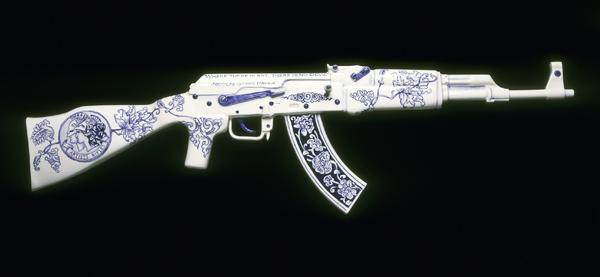La rencontre de la tradition de la porcelaine de Delft avec ses décorations caractéristiques avec le monde dure de l’AK 47 ou Kalachnikov, arme de guerre, arme des « résistants », arme des pauvres.

A propos du créateur :
Charles Krafft is a self-taught painter based in Seattle, Washington USA. His work in the Delft ceramics tradition was inspired by his friendship with American motorcycle and hot rod hero Von Dutch. In the early 1990s, Krafft began a series of natural and socio-political disasters painted on found china plates called Disasterware™, with the logo designed by Von Dutch. In 1995, Krafft traveled to war-ravaged Bosnia Herzegovina with the Slovenian industrial rock band Laibach. Moved by the plight of the besieged residents of Sarajevo, he returned to Central Europe and created an arsenal of Delft weaponry. The Porcelain War Museum Project premiered at the Republic of Slovenia Ministry of Defense headquarters in Ljubljana in 2000, and has subsequently been exhibited in galleries and museums around the world.
During an Arts/ Industry Residency at the Kohler Co. Pottery in 1999 Krafft began creating human bone china memorials and reliquaries based on a formula invented by the British porcelain manufacturer Josiah Spode.
Krafft substituted ball milled human crematory ash for Spode’s percentage of calcinated cow bone in his clay body, resulting in a product he calls SPONE™.
He launched this idea at the “Ring of Spone” performance-exhibition in 2003 at the Arthur A. Wright Chapel columbarium in the Mount Pleasant Cemetery in Seattle. SPONE tm was subsequently featured in two special editions of Ripley’s Believe It or Not! Consulting with friends and relatives of the deceased, he continues to create unique personalized memento mori on commission.
Krafft’s primary technique involves slip cast porcelain and earthenware forms fired at high temperatures. These sculptural objects are then meticulously hand painted and glazed or decorated with ceramic transfer decals before a final firing. This process, based on Dutch delft and Italian majolica traditions, results in artworks that are at once alluring and grotesque – infused with fine craftsmanship and darkly humorous social commentary.

